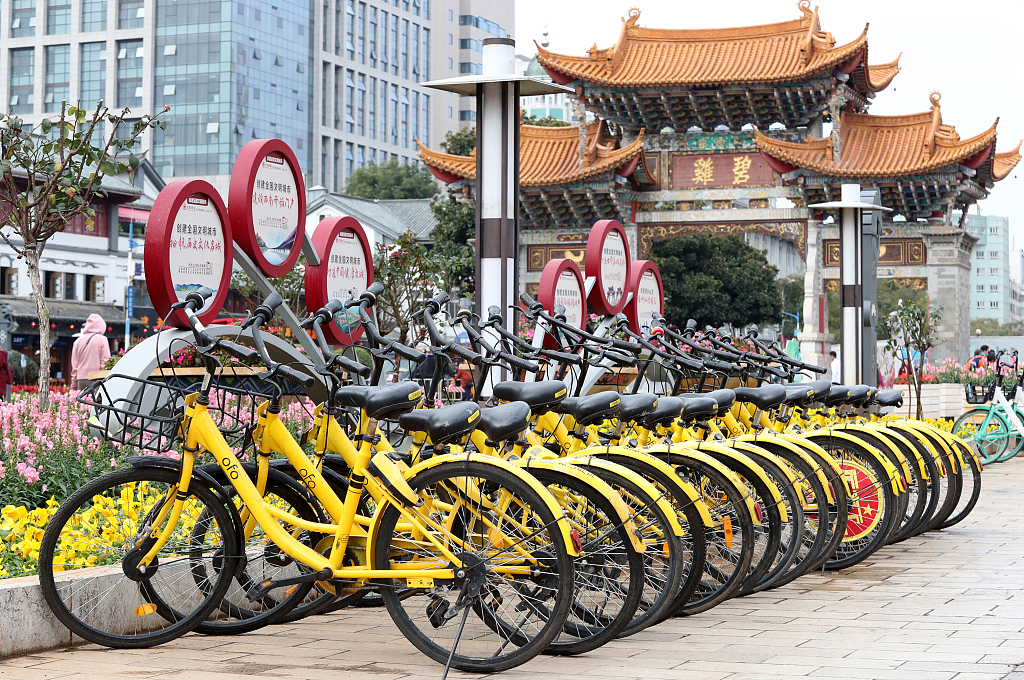

Editor's note: Ravish Bhatia is a former Peking University Yenching Scholar from the cohort of 2017. The article reflects the author's opinions and not necessarily the views of CGTN.
After briefly living in Beijing, I moved back to India last year. Having gotten used to digital payments via the Alipay app while in China, I quickly transitioned to Paytm (the primary digital payments app and equivalent of Alipay in India). Upon first downloading the app, I could not help but notice the striking similarities between the two – from the User Experience (UX) design to the services offered, it almost felt like using Alipay itself. Of course, I wondered if the fact that Alibaba was one of the main investors in Paytm had anything to do with the resemblances. I let the thought go as mere speculation.
A few days later, while walking on the hip streets of Bangalore (India's technological hub), I saw yellow bikes perched on the streets next to chai stalls and towering co-working spaces.
My immediate instinct was to open my Ofo app (a Chinese bike-sharing application) and unlock a bike, but just as I was about to do so, I realized that it was a local Indian bike sharing company called Bounce. The ride sharing company does not exist before I left for China, so it was the first I saw it. After a series of such instances, I could not let the semblances pass by as mere speculation and I start wondering how India and China, the two large developing economies are increasingly becoming closely coupled with each other in the technological and start-up domains.

Ofo bikes along the pedestrian walkway in Kunming, Yuannan Province, Dec 8, 2018. /VCG Photo
This trend is not limited to the two countries. In fact, as developing economies across the world push for greater innovation and simultaneously shift to tech-enabled business models, an increased technological coupling is being witnessed not just between the developed world and the developing world, but within the later as well.
The similarities in markets and the common needs that arise from being in a comparable developmental cycle combined with the shared push for technological development make the basic reasoning for the commonality of this trend.
For example, staying on the case of India and China, policymakers and pharmaceutical companies in China are increasingly looking to the frugal "Indian model" of innovation in generic drug manufacturing (which is affordable and effective) instead of the Western big pharma led model. Meanwhile, Indian policymakers are increasingly looking to China for reference in framing their own domestic industrial policies in advanced areas such as Artificial Intelligence. Social live streaming in the consumer internet industry gained ground in Asia and fast spreads to other parts of the developing world, which changed the way how people interact.
The reason I find it important to highlight this trend, is that it's the first time in human history, we are going to witness an industrial revolution after the widespread globalization. Every major industrial revolution that took place before had its contours set in one part of the world, which slowly diffused to the rest of the world over the years in technological transfers. Instead, this time there are two important considerations that accompany the industrial revolution.

A pharmacy in India, March 14, 2016. /VCG Photo
First, the world is much more connected now than ever and so new technological development is likely to spread much faster, which means that developing countries are likely to reap the benefits of technological growth in other parts of the world much sooner than they would have a hundred years ago.
Second, there is no single hub for technological development and both the East and the West are depending on each other for knowledge sharing. Rapid internationalization in research and development (R&D) has meant that firms have set up multiple R&D labs beyond just their country of headquarters, often in emerging economies with skill pool with lower cost.
Global industrial standards for new technologies are dependent on patents coming from stakeholders across the world. Financial liberalization has led to freer capital flows and information outburst in the internet economy has meant that business models in one part of the world can be easily replicated in other parts. All these have led to greater technological coupling among the developing countries, leading to lesser dependence on the developed world.
It is important to stress here that since most discussions on the global stage revolving around the onset of the new industrial revolution is undertaken from the lens of the developed world. And such conversations frequently miss out on the unique challenges and opportunities that the developing world faces from the oncoming wave of industrialization. As emerging economies get more and more technologically coupled, there is a need for the developing world to shape their own conversations and design an engagement strategy that will lead them together into the new industrial age.
The recognition that the developing world is more technologically connected than ever before will matter a lot when thinking about how the developing world should respond to the fourth industrial revolution. It is imperative we give this fact the attention it deserves and not just look single-mindedly towards the developed world for growth.
(If you want to contribute and have specific expertise, please contact us at opinions@cgtn.com)

Copyright © 2018 CGTN. Beijing ICP prepared NO.16065310-3
Copyright © 2018 CGTN. Beijing ICP prepared NO.16065310-3